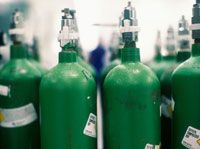Fueling the Fire: Blowtorch Gases
Blowtorches can use different gases depending on the kind of work done. Professional gas torches use acetylene or MAPP gas to mix with oxygen, while smaller, home torches typically use either butane or propane.
Let's start with acetylene. Although highly effective, acetylene (C2H2) is a volatile fuel gas. The volatility stems from acetylene's triple carbon bond. This kind of bond can hold a considerable amount of energy that releases when ignited. However, the bond's unstable nature means it can suddenly explode unless it is kept at the proper pressure (between 15 psi and 29.4 psi, where psi stands for pounds per square inch). Even sudden bumps and small shocks can cause an explosion. Dissolving acetylene in acetone helps keep it more stable, but it is still dangerous and must be stored properly; that is, upright, otherwise the acetone can came come in contact with and harm the other equipment, such as the regulators, hoses or torch head.
Advertisement
Compared to acetylene, MAPP gas, which is made up of methylacetylene and propadiene, is much less dangerous. Unlike acetylene, MAPP gas is not prone to explosion if the cylinder is hit or bumped. It also can withstand higher pressures, which means it's good for underwater work, like repairing ships. Although MAPP gas flames cannot burn as hot as those of acetylene, some claim that it meets or exceeds the performance of acetylene in welding [source: Fundamentals of Professional Welding].
Because oxygen is needed to sustain any flame, it also plays an essential role in the use of all blowtorches. But why, if the gas is naturally present in the air, is a cylinder of compressed oxygen necessary? Because without it, neither acetylene nor MAPP gas would burn nearly as hot as they do. Oxygen acts as an accelerant, which means that it helps the fuel to burn at a higher temperature.
Welding torches typically use oxygen and acetylene (hence the name "oxyacetylene torch") because together they produce flames ranging from 5000 degrees Fahrenheit to 6000 degrees Fahrenheit (2760 degrees Celsius to 3316 degrees Celsius). In fact, the oxyacetylene combination produces hotter flames than any other gas combinations. Adding pure oxygen to the flame increases the performance of acetylene by more than 1000 degrees Fahrenheit (538 degrees Celsius), and that of MAPP gas by more than 1500 degrees Fahrenheit [source: Bernzomatic].
Considering the blistering flames, it's important to know what you're doing before you decide to light up a blowtorch. In the next section, we'll take a look at the safety measures involved in starting one.
